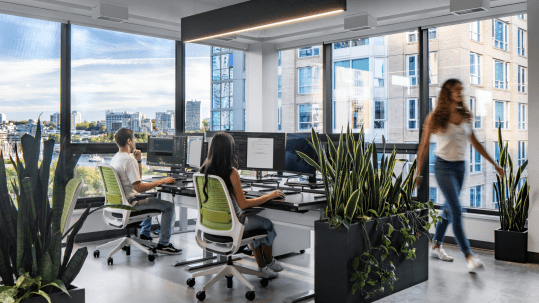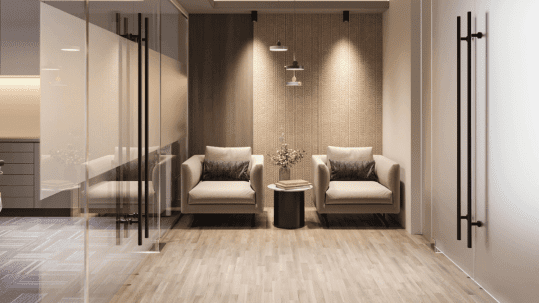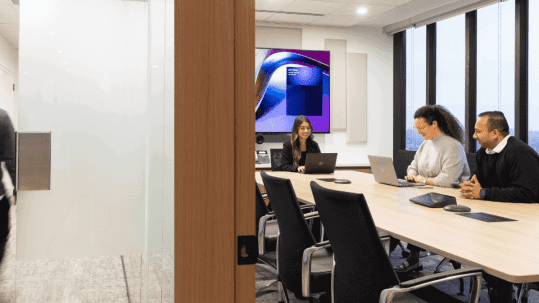We hosted the latest edition of our TenantTalks in-person events on June 1st, 2022, supplying insights on Designing the Workplace of Today.
The pandemic has changed the way we work. The past two years have enabled millions to question conventional notions of work and life. It is clear that we will not return to the way we once operated. Now we are somewhat on the other side and have begun or are well on our way to implementing long-term work modalities, systems, and approaches for our teams and the new world of work we find ourselves in today. This panel of industry professionals from various sectors, moderated by Kraig Docherty, discussed their experiences designing their current workplace.
More of a watcher than a reader? Watch the video recording of the TenantTalks event HERE.
To begin our discussion on designing the workplace of today, we asked the panellists to introduce themselves and their work style strategy. On our panel today, we have:
- Carol Graziani, the Director of Diversity and Inclusions at Best Buy, says their work style is remote first. The corporate office has 1,200 employees and just shifted their office space from 140,000 sq/ft in Burnaby to 70,000 sq/ft in Mount Pleasant.
- Arnaud Bussieres, The CEO of Clearly, is also remote first. Their head office has 200 employees, and their office space is 11,000 Sq/Ft.
- Keri Fraser, the Chief People Officer of Westland Insurance, a hybrid first, has some remote-only employees due to opening their doors and attracting talent from all over Canada.
- Christiane Schoenbaechler, the Senior Manager of Business Operations of Deloitte and their work style is hybrid. There are 1,200 employees in Vancouver, and they recently switched workspaces and will move into their new 100,000 sq/ft office at the end of June.
Q 1: Why did you decide to keep a physical office?
A company may choose to keep a physical workspace for several reasons. Our panellists mainly discussed this because their employees wanted a place where they could connect with one another and congregate to foster a more collaborative workplace. Arnaud, the CEO of Clearly, states that they decided to keep a physical office because they wanted a home base for when people want to connect. If they wish to connect with the team, the company’s purpose or culture, a physical connection once a month is ideal. Furthermore, Arnaud goes on to say that the office,
“Is a place of energy, when you exit the elevator there is music, there is a vibe which I think is very energizing for everybody”
Keri, the Chief People Officer at Westland Insurance, and Carol, the Director of Diversity and Inclusions at Best Buy, raise the point that not everyone has office space at home. If they can work from home, some people struggle with a work/life balance when working remotely. A physical office is critical so people can break their routines and not work 24/7. Often, the decision is not made by the CEO or the executive team but rather by the employees’ desire and need for physical space. A workplace produces a distinct energy that cannot be replicated in a remote environment.
Q2: How are you accommodating the different work styles?
Throughout the event, several work styles were mentioned. There are currently many work styles, ranging from remote exceptions to hybrid remote and beyond. But, because not everyone works the same way, how are companies accommodating these different work styles?
Christiane, the Senior Manager of Business Operations from Deloitte, stated that boundaries and guidance are essential. At Deloitte, they have a team pledge where teams talk to each other about how they work and how they can accommodate the hybrid or work/life balance.
Moving forward, Keri from Westland Insurance emphasizes the importance of trust. Westland has a policy that requires employees to come into the office two to four times per week; however, there are no strict rules that require employees to come in on the same days or the same number of days each week. She adds that we allow managers to manage that with their team and do what works best for them.
“We have faith in managers working with their teams to decide the best work style for them”.
Q3: Regarding office design, what are the most critical design elements that were changed or added as part of your redesign?
To successfully design today’s workplace, several changes must be implemented into your new office design to meet your workforce’s demands better.
Carol begins by telling the audience that a notable change at Best Buy was reducing desk space in favour of increased collaboration. She says that they created a variety of spaces in which people can collaborate, some of which are traditional meeting rooms and some of which are small drop-in spaces. A significant investment was also made in meeting room technology. This technological investment is
“Important to us because it allows people who are not in the room to feel just as included as those who are. Overall, there was a significant investment in technology to ensure that everyone is seen and heard.”
Keri states that their new office was designed around Westland’s culture and values.
“After the workplace assessment study, we spent a lot of time thinking about what we want the space to say when somebody walks in. And it was around being welcoming, approachable, inclusionary, humble and so in the design elements everything is really surrounding that.”
An important design feature we changed was restructuring our office to remove hierarchy. The best pieces of real estate are for our employees to use. There are now fewer offices, all of which are the same size, found on the inside, do not belong to anyone, and can be booked by anyone. Overall, every decision we made came back to who we are at Westland.
Q4 Who from your team was involved in the office redesign?
When designing or redesigning your workplace, several people should be considered. Here is a list of the top people our panellists said were involved in their office design process.
- Marketing and Communications leader: Because workplace design is also about branding
- An elective representative from every team: this is a beautiful way to make sure every department is heard.
- Change management consultant: this is an excellent idea to bring in professional help to aid in the design process
- CEO and CFO: making sure stakeholders are aligned with the company’s vision is a terrific way to keep everyone on the same page
- Diversity and inclusion specialist: this is important in thinking about what makes a workplace inclusive.
Q5 What were the biggest learnings and challenges?
There will be obstacles to overcome when restructuring your workplace, but there will also be many valuable lessons learned. Here is what our panellists had to say about their biggest takeaways and roadblocks:
Arnaud tells us that the biggest problem for Clearly was how do you engage people remotely. How do you make sure communication is clear?
“You really must give employees a purpose and it is crucial to train managers on how to use the space and how to communicate in the new environment.”
An important lesson this process has taught us is to pay much attention to training, communication, and engagement.
Keri said another issue was that their employees’ expectations kept changing. Westland began by moving to a new office, transitioning to a hybrid work model, and learning new programs like the desk booking app. Keri describes it as “change after change after change.” And, because their expectations were shifting, we needed to be deliberate in our design and have a compelling reason to bring employees to the office. We brought on a senior workplace experience manager halfway through the project. Keri explained that they could not have done such an excellent job without her help and wished she had joined us sooner. A key takeaway from this whole experience, and something I would do differently next time, is bringing her on sooner. We needed to have someone who truly owned the employee experience in terms of office design.
Q6 What are some other vital things that were changed as part of onboarding?
Carol begins by saying Best Buy has implemented an allocation program that directly enhances their employees’ home offices. Everyone gets two monitors and everything else they need to work effectively from home.
“In order to support an easier transition to working remotely we give our employees a supplement and a good discount at Best Buy. We really encourage our employees to leverage their employee discount and trick out their setup.”
Adding onto this, Keri brings up an unexpected change that arose was their IT inventory. She tells us that at the start of the pandemic, everyone took their stuff home and then during that time, we decided to move to hybrid. Furthermore, to smooth that experience and make it easier for people to come back and forth, we went to every desk and figured out what was missing so they could leave the stuff they brought home at home. After, we made a standard package at every desk so people could book wherever they wanted.
Q7 Do you have a new operating cadence due to this new way of working?
Arnaud talks about how at Clearly, they try to do an in-person event for all employees once a month. He explains that before, they always had a company town hall where they would give updates on the company’s performance once a week. However, now it is a mix of in-person and remote meetings. Furthermore, they encourage managers to have in-person team meetings once a month. Lastly, Clearly is very invested in community outreach. Therefore, they also have two community events a month in person.
Carol then raises an interesting point, stating that they are not mandating anything; however, they expect each leadership pyramid to have their team come in at least once a quarter. Best Buy strongly advocates for stacking meetings so that if employees must travel to the office, their time is well spent between various meetings and social events on the same day. Moreover, because of the highly collaborative nature of their work, many people participate on multiple teams, so they found a spectrum from 4 times a year to 24 times a month. Hence, we are also concerned about balancing too much office time and ensuring that when people come into the office, there is value in the 67-minute commute for them.
Q8 Are there any metrics or KPIs you are watching or reporting on to measure the success of this new way of working?
To begin, Carol states that Best Buy will go back in the fall with another detailed survey to get feedback from their employees on specific things. So that they can weigh what works, what does not and what they value the most.
Arnaud agreed, stating that assessing their employees’ feedback is an effective way to see how people feel about the changes they have implemented in their new workplace. Every quarter Clearly does an in-depth engagement survey with all employees, around 35 questions. Then monthly, they do a quick poll, which is offered to the managers to send to their team about how they are feeling today, rating from 1-4. Therefore, the engagement piece for Clearly allows them to see how people think and will enable them to give feedback.
Keri adds that Westland would also like to do more engagement. Westland conducts regular surveys on a survey platform. However, when measuring the success of their new desk booking app, they have a specific set of questions in mind, such as how the space is being used. How often do people come in? On Which days? What are the most popular areas? Moreover, all this information will enable them to proactively and strategically manage that space.
Lastly, Arnaud brings up another KPI he and his team keep track of monthly, which is the turn of employees. They want to determine if they see an acceleration in turn or retention issues after changing the layout and office design.
Q9 Any final thoughts or golden nuggets of advice you have?
To conclude our questions, we asked our panellists for their final thoughts and any advice they had for people wanting to design or redesign their workplace.
Carols starts us off by stating not to be afraid to test things. Test things in particular zones and see how people respond to them. I would try ideas and then see how people interact with them before you make a big decision to invest across the board.
Christiane follows this by recommending people be adaptable and open to new experiences. “Things will continue to change; I know we’re all tired and want things to calm down, but they won’t.” Be proactive about walking around and talking to people, be open to hearing what people want, be observant, and avoid taking things personally. Adding to this, Keri points out that you must be flexible and ready to pivot. Things are constantly changing, and it is okay to acknowledge that you do not have everything figured out. Think of the office as a part of the employee experience and ask employees for feedback.
Lastly, Arnaud leaves us with this golden nugget of advice: putting the employees at the core of the entire process is essential. Do not hide behind budget because you can do it for ridiculously cheap. All managers must be brave and push for change, which is fantastic for employees. Not adapting after two and a half years shows a lack of courage.
Conclusion
Thanks to all who attended this TenantTalks discussion. It was fascinating to hear industry experts discuss current workplace trends and strategies for designing the workplace of today. Listen to our panellists’ complete discussion, audience questions and answers, and any other highlights not mentioned in the recap. Watch the full TenantTalks video recording HERE.






